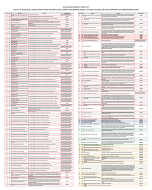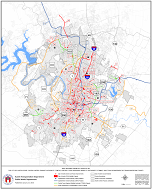Today the Mayor and City Council kicked off the “Year of Mobility” by announcing that the City and regional partners are coordinating efforts to make progress on hundreds of transportation projects across the city that will ease congestion, make traffic safer, and plan for the future. Announced today are a total of 109 projects not including regular street maintenance, the mobility improvements paid for out of CapMetro funding to be approved today, and other regular projects such as filling potholes, new striping on roads, and maintaining landscaping.
“The City of Austin and our partners in the region are serious about making progress every day on the transportation challenges we all face. Over the next year, you will see progress that moves us closer to our goal of a safe and effective transportation system, where people have choices about how they get around the city,” said Ann Kitchen, Chair of the Council Mobility Committee.
“We’ve got so many shovel-ready projects lined up that we’re going to run out of shovels. We’re going to cut so many ribbons that we’re going to need to find a place to sharpen our giant pair of scissors. It’s getting harder for people to get to work, so people expect us to get to work, and that’s what we’re doing,” said Mayor Steve Adler.
Citywide Projects Map
The below list includes but is not limited to this sample of major milestone in Mobility and Congestion Management , Safety, Innovation, that will be reached in 2016:
Mobility and Congestion Management:
- Continuation of the Traffic Congestion Action Plan to retime signals to reduce congestion and travel times, repair vehicle detection systems at intersections to reduce wait times for signal changes, limit construction closures, better manage special events, and continue the Don’t Block the Box campaign.
- 9 street reconstruction projects
- Expand the 20/20 Mobility Challenge to major employers to reduce single occupancy vehicle trips during rush hour by twenty percent (or more) by 2020. Some of our biggest downtown employers have already committed to the challenge, and the City of Austin has already met the 20% goal for its own employees.
- Invest in transportation technology via our Advanced Transportation Management System to better use data to improve travel times.
- Improvements to major intersections, streets, and bicycle and transit infrastructure, including:
- Improvements to E 51st from Berkman Drive to US Hwy 183
- Extension of Parmer Lane from US Hwy 290 E to SH 130 Toll Road
- Open a dedicated bicycle facility on the MoPac mobility bridges
- Improve mobility and parking on Rainey Street from Driskill St. to River St.
- Corridor improvements to Riverside Drive, including intersection improvements at S Lakeshore Blvd
- Improvements to Todd Lane from Ben White Blvd to St. Elmo Rd to accommodate traffic and improve pedestrian and bicycling access
- Improvements to E 7th St. & N. Pleasant Valley Road intersection
- Completion of the Upper Boggy Creek Trail to connect the MLK MetroRail Station to E 12th Street and surrounding neighborhoods
- Expansion of the Howard and Lakeline park & rides to accommodate the growth in drivers who are choosing to use MetroRail and MetroExpress buses to commute
- Study potential signal improvements at Parmer Lane from SH 45 to Whitestone Blvd
- Regional transportation agencies will continue to collaborate on a variety of major improvements on our most congested corridors, including: North and South MoPac, SH71, 183, the Y at Oak Hill, and more.
Safety:
- Adopt and begin implementation of the Vision Zero Action Plan.
- Complete design and begin construction on improvements at five of Austin’s most-dangerous intersections.
- 6 Local Area Traffic Management Projects (which are requested by citizens)
- 11 Road/Intersection Improvements projects, including the 5 Intersection Safety Improvement Projects funded by Council in Oct 2015
- 3 Signal Projects, including a PHB on N Lamar Blvd, north of Parmer Ln; new signal at S Lamar Blvd and Toomey Rd, and the Parmer Ln Signals Study with the City of Cedar Park
- Start construction on IH-35 and 51st Street total mobility and safety improvements to include upgrading signals, improved travel time, and enhanced safety for bicyclists and pedestrians.
- Additional investment in Pedestrian Hybrid Beacons and other infrastructure improvements at key locations thought the city to improve safety pedestrians.
- Make intersection safety improvements to I-35 Service Road Southbound and E MLK Drive; N Lamar Blvd and Rundberg Lane; N Parmer Lane and N Lamar Blvd; US Hwy 183 and Cameron Road; W Slaughter Lane and Manchaca Road
- Install new signals to enhance safety at S Lamar Blvd and Toomey Road
Innovative Projects:
- With our government and private sector partners, Austin will apply for the US DOT’s Smart City Challenge, which seeks new ways to use technology to improve travel for everyone.
- Continue our partnership with the Rocky Mountain Institute, which recently chose Austin, Texas from among cities nationally to be the lead city in an effort to leverage emerging technology and business innovation. The effort enhances mobility options, in turn reducing congestion, decreasing costs, improving the environment, and more. Denver, Colorado is also a partner in the effort working to test scalability of different projects.
Planning for the future:
- In 2016, Austinites will help shape a new transportation vision for our city. An updated Austin Strategic Mobility Plan will harness community input and guide transportation improvements moving forward. The ASMP will include an updated transportation vision, goals, objectives and action items. Combined with our Imagine Austin Comprehensive Plan, the ASMP will connect land use and transportation to create a more integrated and comprehensive plan for the future for our City.
- Continue to work with TxDOT on planning efforts to improve traffic flow on Loop 360, RM 620 and Parmer Lane.
- The City Council, through its membership on the Capital Metro Board of Directors, and the Austin Transportation Department, will collaborate with Capital Metro as they conduct an in-depth review of the transit system through Connections 2025. The review will ensure that Austin residents’ best interests regarding transit and mobility are considered.
- We will also partner with Capital Metro on their Central Corridor Study – an in depth study of potential high-capacity transit solutions for Austin.
Neighborhood Connections:
- 5 Neighborhood Partnering Program Projects that include 2 cycle tracks (on Hancock Dr and Arroyo Seco), EM Franklin Green Street Project, and 2 urban trail improvements (Davis Lane Trail Segment & Lighting the Shoal Creek Trail)
- Construction of new sidewalks and bicycle connections in every part of the City.
- 6 urban trail projects: Upper Boggy Creek Ph 1; MoPac Bicycle Bridge over Barton Creek; Country Club Creek Trail Ph 1; Violet Crown Trail – North; Violet Crown Trail – South; and Northern Walnut Creek Hike and Bike Trail Phase 1
- 44 Sidewalk/Pedestrian Projects, including 2 named projects – Sabine St Promenade and Landside Roadway and Pedestrian Improvements (located at ABIA, includes a new pedestrian pathway and improved traffic flow at specific intersections)
- 25 locations for curb ramp improvements, throughout the City
- In addition, the Council is expected to approve $21.8 million in additional mobility improvements in every Council district (1/4 cent funds), including neighborhood traffic calming, intersection improvements, sidewalks, and safety improvements.
- The Mayor and Council Members stressed that even with all of the progress that will be made in 2016, there is a need to start a discussion with the public about funding for future transportation projects. The entire City Council has been invited to the next Mobility Committee meeting, Feb. 3, to kick off a community discussion about how Austin can fund the next big transportation initiative and which project(s) can be included.
- “Great cities do big things, and there is nothing bigger facing Austin right now than our mobility crisis. It’s no secret that I-35 is the most congested road in Texas,” said Mayor Steve Adler. “We need to have a serious conversation in this community about how we move from the drafting board to fixing I-35 and investing in transportation projects on other major corridors such as Lamar, Burnet Road and East MLK that we need to tackle in the near future.”
“We have asked our community for years to provide input and feedback on numerous transportation projects to develop plans for future deployment. Now, it is time we do something. I want to see the City implement the plans that our community has spent so much time and effort developing,” said City Council Member Ann Kitchen.


